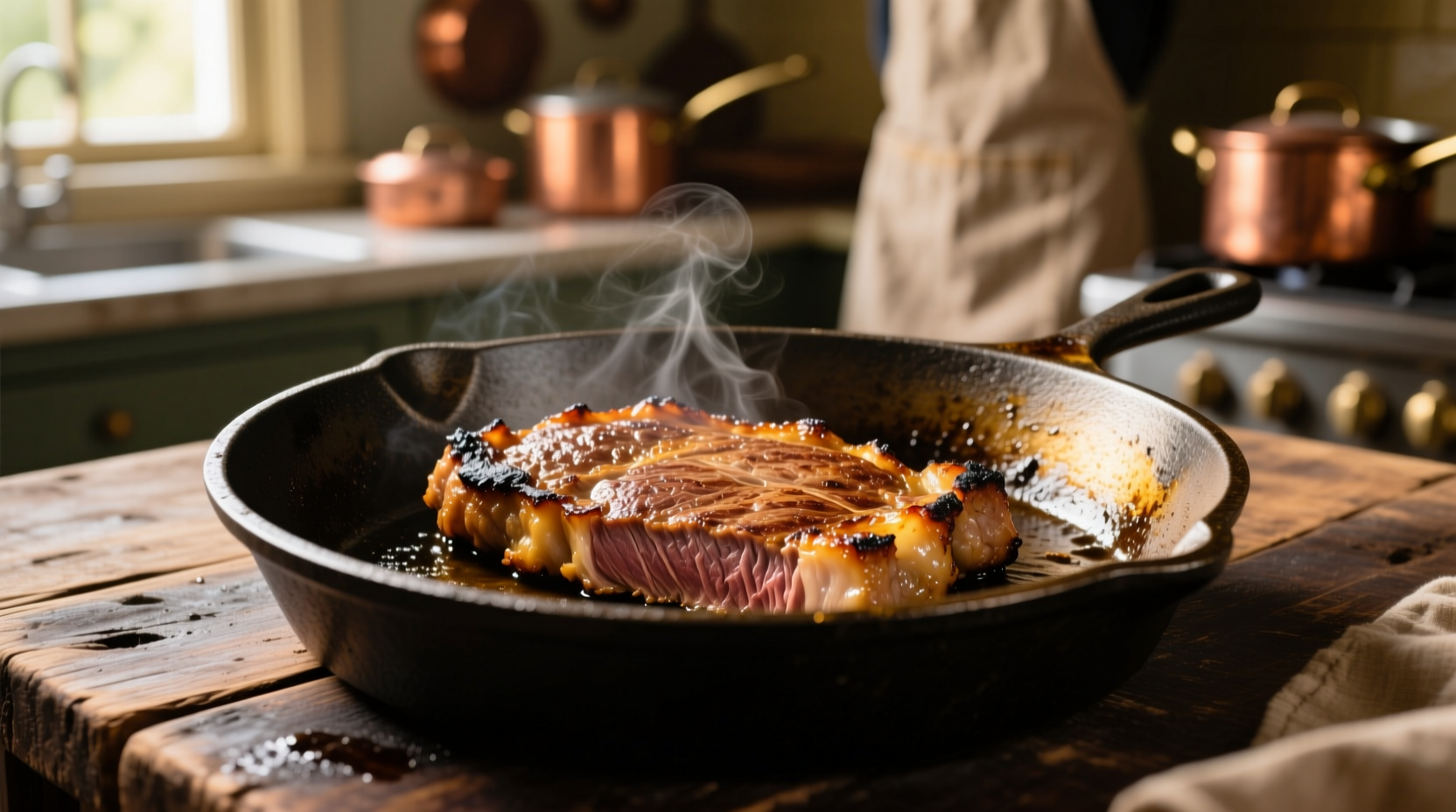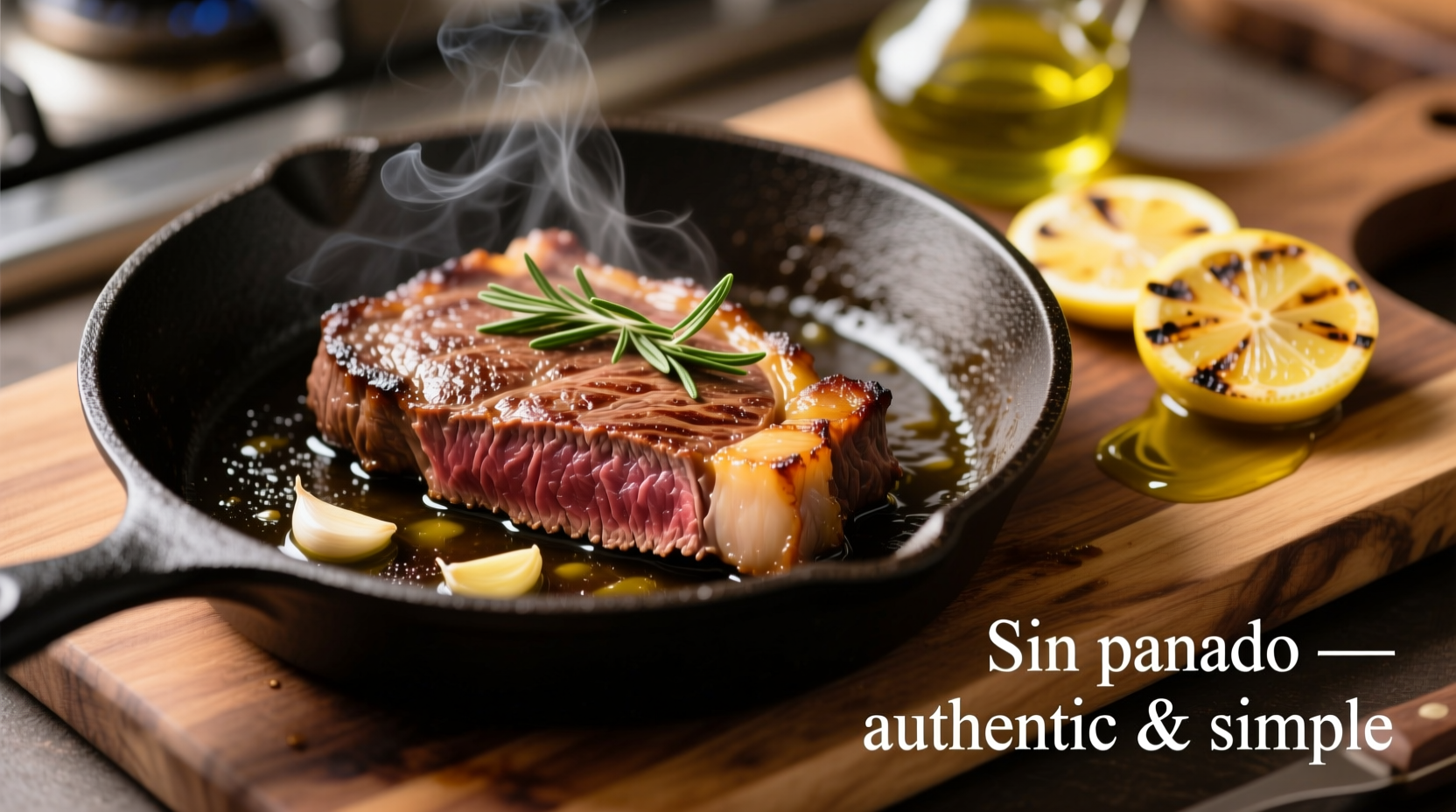Why Ditch the Breading? The Modern Milanesa Approach
Traditional milanesa relies on breadcrumbs for its signature crunch, but this modern adaptation delivers equal satisfaction with less preparation time and dietary flexibility. By understanding the Maillard reaction—the chemical process that creates browning and flavor when proteins meet high heat—we can achieve that coveted crispy exterior through proper searing technique alone.
According to the USDA Food Safety and Inspection Service, cooking steaks to an internal temperature of 145°F (63°C) with a 3-minute rest ensures both safety and optimal texture. This breading-free method makes temperature monitoring significantly easier than with traditional breaded versions.
What Makes This Method Work: The Science Behind Crispy Steak
Without breadcrumbs, achieving that signature milanesa crispiness depends on three critical factors:
- Dry surface—Moisture is the enemy of browning. Pat steaks thoroughly with paper towels before seasoning
- High smoke-point oil—Avocado or grapeseed oil (smoke point 500°F/260°C) works better than olive oil
- Proper pan temperature—The oil should shimmer but not smoke excessively when steaks hit the surface
| Traditional Breading Method | Breading-Free Alternative | Key Advantage |
|---|---|---|
| Requires 3-step dredging process | Direct seasoning application | Saves 15+ minutes preparation time |
| Gluten-containing breadcrumbs | Naturally gluten-free | Suitable for celiac and gluten-sensitive diets |
| Fry oil absorption (30-50g fat/serving) | Minimal oil absorption (10-15g fat/serving) | Significantly reduced fat content |
Essential Ingredients for Perfect Breading-Free Milanesa
You'll need just six ingredients for authentic flavor without breadcrumbs:
- Steak selection: Thin-cut sirloin (¼-inch thick) or top round—these cuts work best for quick cooking without drying out
- Dry rub: 2 tsp smoked paprika, 1 tsp garlic powder, ½ tsp onion powder, ½ tsp dried oregano
- Salt and pepper: 1 tsp kosher salt and ½ tsp black pepper per pound of steak
- High-heat oil: 2 tbsp avocado oil (smoke point 520°F/260°C)
- Finishing touch: Fresh lemon juice and chopped parsley

Step-by-Step Cooking Process
Preparation Phase (5 minutes)
- Remove steaks from refrigerator 20 minutes before cooking to reach room temperature
- Thoroughly pat dry with paper towels—critical for proper searing
- Mix dry rub ingredients and generously coat both sides of steaks
- Let seasoned steaks rest for 5 minutes to allow seasoning to adhere
Cooking Phase (12-15 minutes)
- Preheat cast iron or stainless steel skillet over medium-high heat for 3 minutes
- Add oil and wait until it shimmers (about 350°F/175°C)
- Carefully place steaks in hot pan, leaving space between pieces
- Cook undisturbed for 3-4 minutes until golden brown crust forms
- Flip and cook additional 3-4 minutes for medium-rare (adjust for desired doneness)
- During last minute, add 2 tbsp butter and baste steaks for enhanced flavor
Resting and Serving (5 minutes)
- Transfer steaks to cutting board and rest for 5 minutes
- Squeeze fresh lemon juice over finished steaks
- Serve immediately with chimichurri sauce or your favorite accompaniments
Common Challenges and Solutions
When cooking milanesa without breading, these issues commonly arise:
- Steak sticks to pan: Ensure proper preheating—the oil should form a thin, even layer that shimmers. Don't move steaks until they naturally release.
- Uneven browning: Use consistent thickness cuts. If needed, gently press thinner areas with a spatula for even contact.
- Dry texture: Don't overcook—thin steaks cook quickly. Use a meat thermometer to verify 130-135°F (54-57°C) for medium-rare.
When This Method Works Best (and Limitations)
This breading-free approach excels in specific scenarios but has important limitations:
- Ideal for: Weeknight dinners, gluten-free diets, low-carb/keto eating plans, and when you need minimal cleanup
- Less suitable for: Thick-cut steaks (over ½-inch), when serving to traditionalists expecting classic breaded texture, or for meal prep (best served immediately)
- Temperature tip: For thicker cuts, finish in a 400°F (200°C) oven after searing to ensure proper internal temperature without burning the exterior
Traditional Serving Suggestions
Milanesa without breading pairs beautifully with classic Latin American accompaniments:
- Argentine-style chimichurri (parsley, garlic, vinegar, olive oil)
- Simple side salad with vinaigrette dressing
- Roasted potatoes or sweet potato wedges
- Crisp white wine like Torrontés or Sauvignon Blanc
Make It Your Own: Flavor Variations
Once you've mastered the basic technique, experiment with these authentic variations:
- Argentine twist: Add ½ tsp crushed red pepper flakes to the dry rub for subtle heat
- Italian-inspired: Finish with a sprinkle of Parmesan cheese during the last minute of cooking
- Herb-infused: Add fresh rosemary or thyme sprigs to the pan while cooking for aromatic depth
Why This Method Has Gained Popularity
The evolution of milanesa preparation reflects changing dietary preferences over the past decade. Originally brought to South America by Italian immigrants in the late 19th century, traditional milanesa required time-consuming breading. Recent culinary trends toward simpler, more health-conscious cooking have driven the popularity of this streamlined version—particularly among home cooks seeking authentic flavors without gluten or excessive preparation time.











 浙公网安备
33010002000092号
浙公网安备
33010002000092号 浙B2-20120091-4
浙B2-20120091-4